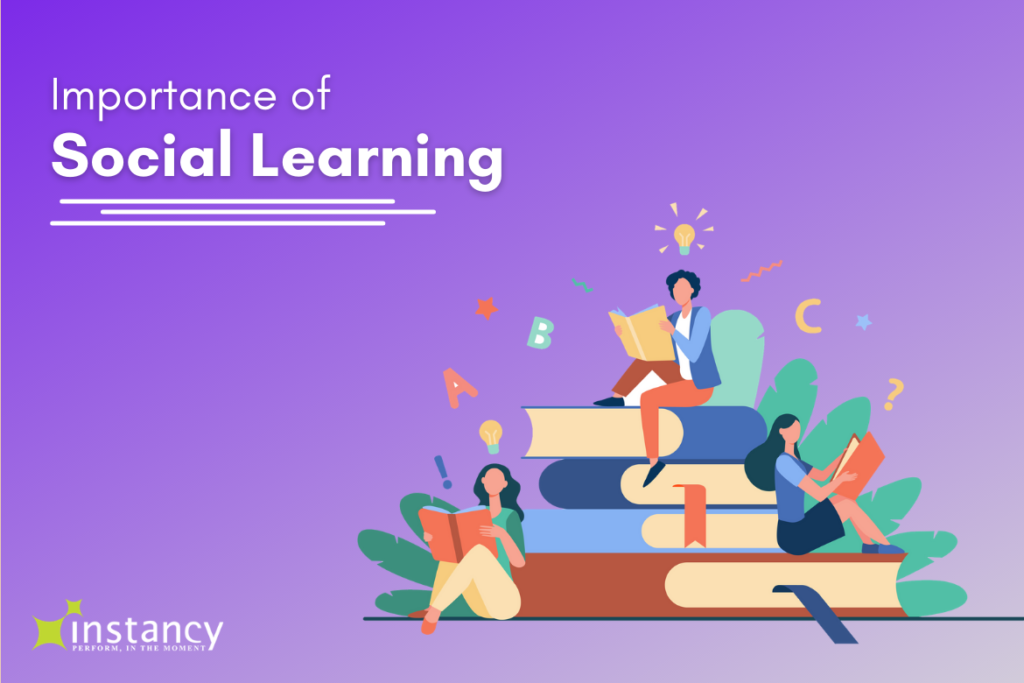Social learning became the go-to workplace training approach during COVID-induced lockdowns. And it made sense as businesses unleashed multifaceted benefits.
Read on to understand why you must adopt social learning as the way going forward in an age where managing remote teams is the new norm.
Social Learning theory is no novelty. It has been around since the early 50s as an instrumental teaching and learning model.
Aristotle once said that humans are “social animals.” Not anymore! Humans of the 21st century have shattered the shackles of being just “social” to coin what we today call the “supersocial age.”
When the pandemic forced numerous businesses to make remote working the new norm and standard industry practice, various formidable challenges hopped in without notice or invitation.
How to maintain business culture? How to keep the workforce motivated and engaged? How to remain productive or in many cases, operational? Questions were aplenty!
During the pandemic, business management professionals and corporate think-tanks got enough time to think and come up with ideas to streamline important business processes, teams, and operations.
Numerous businesses realized that providing consistent workforce training, particularly upskilling and reskilling training, helps drastically in streamlining all learning touchpoints for accuracy and management.
Related Read: Mistakes to Avoid When Creating Training Program for Employees
However, the learning model still had serious roadblocks. Most businesses feared that their employees may feel bored, lonely, and isolated when trying to learn things themselves at home.
That’s where social learning again made its importance and need felt.
What is Social Learning and Why is it Important?
Developed in the 50s by legendary psychologist Albert Bandura together with his student Richard Walters, the social learning theory emphasizes that humans tend to learn more efficiently when they learn together.
To put it as a concept, learning is better when people study in a group of two or more. Bandura and Walters emphasized that by exchanging perspectives and knowledge and mentoring each other, learners can understand concepts faster and more efficiently.
Besides, they retain information better than when they learn alone. That’s because learners tend to observe the actions of each other – and make better decisions based on their observations.
Plus, social learning creates an important factor of engagement: people learning in a group are not passive receivers of information (as compared to a learner receiving information through a long Skype presentation). For individuals to learn more effectively, their behavior, environment, and cognition all need to work in tandem and influence each other.
Is Social Learning Nature or Nurture?
Social learning theory has been criticized because of its predominant commitment to the environment that influences human behavior.
The behavior can be least described in terms of either nurture or nature and attempts made in this regard underrate the human behavior complexity. Human behavior can more likely be a result of interaction between nurture (environment) and nature (biology).
How can Social Learning be Applied to Online Education?
The surge in online learning and social media has given social learning a new lease of life. While efficient and cost-effective, online learning makes sure people engage in the learning process more comfortably as they do on social media.
Over the last decade or so, social media platforms have demonstrated that humans can create considerable connections and engage in interactions online. The lockdowns proved how vital these social media interactions can be to one’s mental health.
Given that, how can remote learning and social learning go hand-in-hand? That’s no rocket science, all you need is to add some select social elements to your eLearning processes.
Importance of Social Learning in Workplace
The importance of social learning in the workplace has doubled since the COVID-19 Pandemic. The global lockdown has affected the business world. Socializing with colleagues was once an integral part of the day in the life of an office-going employee. Many learned the corporate ropes by either interacting with colleagues and observing superiors.
The current situation has put a stop to this for the betterment of mankind. But that doesn’t mean socializing or learning through social interactions will stop as well. Social learning can still exist over a learning management system where informal learning and information flow will continue to flourish.
How to Adopt Social Learning in the Workplace?
The merits of social learning in a workplace are cross-functional and deep-rooted. Let us explore how you can adopt it in your workplace environment.
1. Create Teamwork Opportunities
The first step to nurturing the spirit of social learning is to encourage across-the-board teamwork. Employees must be willing and comfortable to share knowledge, questions, and queries with each other. It should come naturally to them.
While assigning a task, emphasize teamwork and be open to ideas on how employees can work collectively on the task whenever possible. Insist for it if the task provides an opportunity for collaboration between employees from different departments who’d normally have no reasons to work together.
2. Make Teamwork Mandatory for eLearning
Integrating social learning essentials into eLearning practices can help you stand apart from the competition.
Writing for Forbes, B2B growth professional Ian Altman warned that there is a major difference between “online communities” and “online training”. He claims that an eLearning model that provides no communication opportunities for its learners is not effective at all.
Training programs that facilitate interaction between the learners (wherein the participants can learn from each other) provide improved overall engagement and pass rates.
With features such as messaging capabilities, file sharing, instant notifications, discussion forums, and gamification aspects like leaderboards, an LMS can be transformed into a social learning hub. Learners can interact, share concepts, clarify doubts, and develop a critical thinking approach.
3. Adopt Feedback-based, Continual Performance Management
Within an environment that facilitates social learning in the workplace, communication must flow in all directions. It means that the managers and employees should receive actionable and consistent feedback regularly. It also means encouraging them to provide feedback often.
Therefore, your LMS must provide the survey feature to promote transparency in the workplace. Surveys can truly add value to your workplace eLearning initiatives.
Organizations with smaller teams can schedule weekly brainstorming sessions instead of creating surveys to suit their custom-build. There, questions and feedback can be shared regarding both the social welfare and professional development of the employees. Employees can also be encouraged to share ideas on how project management and workforce collaboration can be improved.
Benefits of Implementing Social Learning in the Workplace
As per the Training Magazine, social learning was a major eLearning trend in 2020. The adoption of social learning in the workplace has numerous merits for the well-being of both the employees and the organization.

1. Augment Information Retention and Training ROI
As such, the stats favor social learning people retain 10% of what they read and 5% of what they hear. The figures don’t look too promising, right? However, those figures improve dramatically when learners get more actively engaged.
Nearly 50% of the information covered through interactions and discussions is retained. Stats reveal that more than 75% of learning that takes place in a typical on-the-job or live-project experience is retained.
We learn better by doing things and by interacting with fellow learners.
2. Improve Management and Decision-Making
It’s not just the workforce that needs to be engaged and stimulated to improve productivity. Poor management initiative is also a crucial pain point that needs to be addressed for optimal business results.
As per Gallup, poor management initiatives tend to cost $7 trillion worldwide. That’s a whopping 9 to 10 percent of the world’s GDP. As such, poor management leads to disengaged employees and lost productivity – it can play a spoilsport for your entire employee learning program, if not more!
How to resolve it? By including managers in the company’s social learning model!
Providing training to managers is usually a no-brainer for most organizations, but to take that training as part of a separate bubble is the biggest blunder they can make.
Think of it as a choreography trainer. Including trainees of different levels in the class means the trainer can suggest different adaptations of each step to fit different capabilities. This ensures everyone can learn together and make faster progress.
Though companies may not be providing managerial and leadership training to all employees at this point, they may still engage the managers in important social learning aspects such as forums, leaderboards, etc. to facilitate efficient team bonding. When managers feel close to the teams they manage, their team management initiatives improve.
3. Boost Employee Satisfaction and, in Turn, Retention Rate
Employee attrition or retention rate depends on the management and working environment of an organization. Prioritizing employee social welfare and development helps improve the retention rate.
The employees stay engaged, become highly-productive, and are willing to continue with an organization that takes their professional as well as social development seriously.
4. Identify and Prevent Knowledge Gaps
In general, people cover more information when they learn together. With routine activities such as group discussions and team-building drills through gamification/play, companies can address knowledge gaps.
The employees can share knowledge in a way they understand better and, as a consequence, much of it can be retained. When an employee seeks help from others on topics he or she doesn’t know, knowledge gaps across the entire company can is addressed.
5. Nurture an Impressive Company Culture
There’s no second thought that bridging the gaps between employees, particularly now that a lot of them are working remotely, works wonders for morale. Fostering a close-knit team of professionals is the launchpad to impressive company culture. And we all know productivity and success thrive only in great work culture.
The Bottom Line
Adopting social learning in the workplace ensures continuous engagement, information retention, employee satisfaction, and impressive work culture. In addition, it helps forge stronger connections between employees that can help in achieving personal well-being and boost team morale.
However, to successfully capitalize on the benefits of social learning, with specific relevance to the eLearning context, you need the right tools and help.
Investing in the right LMS that provides cutting-edge features such as instant messaging, gamification, discussions, and surveys can ensure you are moving in the right direction.




